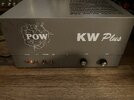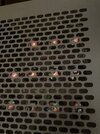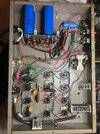The 'sensor' is the antenna relay. It passes the connection between radio and antenna straight through while receiving. The small circuit board to its left in the pic has a small blue lump on it. The lump is a smaller relay that enables or bypasses a receiver preamplifier circuit that's alongside it. One of the front-panel switches turns this feature on or off. If it were a Maco, this would be one position of a three-position standby switch. That small circuit board also contains a sensing circuit. When you key the mike on the radio, it "borrows" a tiny sample of the radio's output power and rectifies it to DC. That tiny DC current activates a transistor that energizes the coil in the big black antenna relay. That relay has three circuits, one for the radio coax socket, one for the antenna coax socket and the one in the center is used to shut down the tubes while receiving, and power them up when the relay closes.
And that's what causes me to suspect a failed tube causing an overload. Can't overload anything until you apply high voltage to it. And that's what that center circuit of the relay does when it goes "click" or gets bumped causing that circuit to close.
Over the years now and again an employee would be testing the tubes from a customer's radio or amplifier and find one with a dark filament that just would not light up. I would suggest making a mark on the wall with today's date, since this is such a rare occurrence. That glowing filament is the most-reliable part of the tube. What cause them to fail will be other parts if the structure inside.
One way to see if I'm right is to unclip the spring clip from the cap on top of all the tubes. This will unhook them all from the high-voltage power. Now turn on the power, warm it up and then press the relay's armature down with an insulated screwdriver handle or some other insulator. If it was a tube that made the fuse trip, the power will stay on. This will tell you that it's time to find a tube tester and identify how many of them look perfect, but have a hidden electrical failure inside. My prediction would be more than just one.
The keying circuit, the RF-sensing feature that keys the amplifier when the radio's mike is keyed is famous for going out in that circuit board. It's either a board they bought from Maco, or copied. We learned the hard way to remove it and use a more-reliable keying circuit in its place. The receiver preamp is a bad idea to begin with.
One last bit of bad news. The four large silver cans with two screw terminals each are too old to be trustworthy. They're called aluminum electrolytic capacitors and the chemistry inside that makes the work always degrades after 20 or 30 years. They're no doubt 40 or more years old.
This model has some other annoying quirks that I'll skip for now. Can't even observe them until you can get it to key up and show wattage. No need to borrow trouble you can't observe.
Yet.
Here's a rundown of the typical 40-year tuneup for a similar model, the Maco 300.
https://www.worldwidedx.com/threads/maco-300-gets-47-year-tuneup.268043/
You don't have to go to quite that extent. I just don't like getting called a week or a month after a repair to hear that it has a problem. When one of these goes home, it needs to stay home.
(edit) Whups! Just noticed I posted the link to the 300A refresh twice. Still relevant, though.
73



